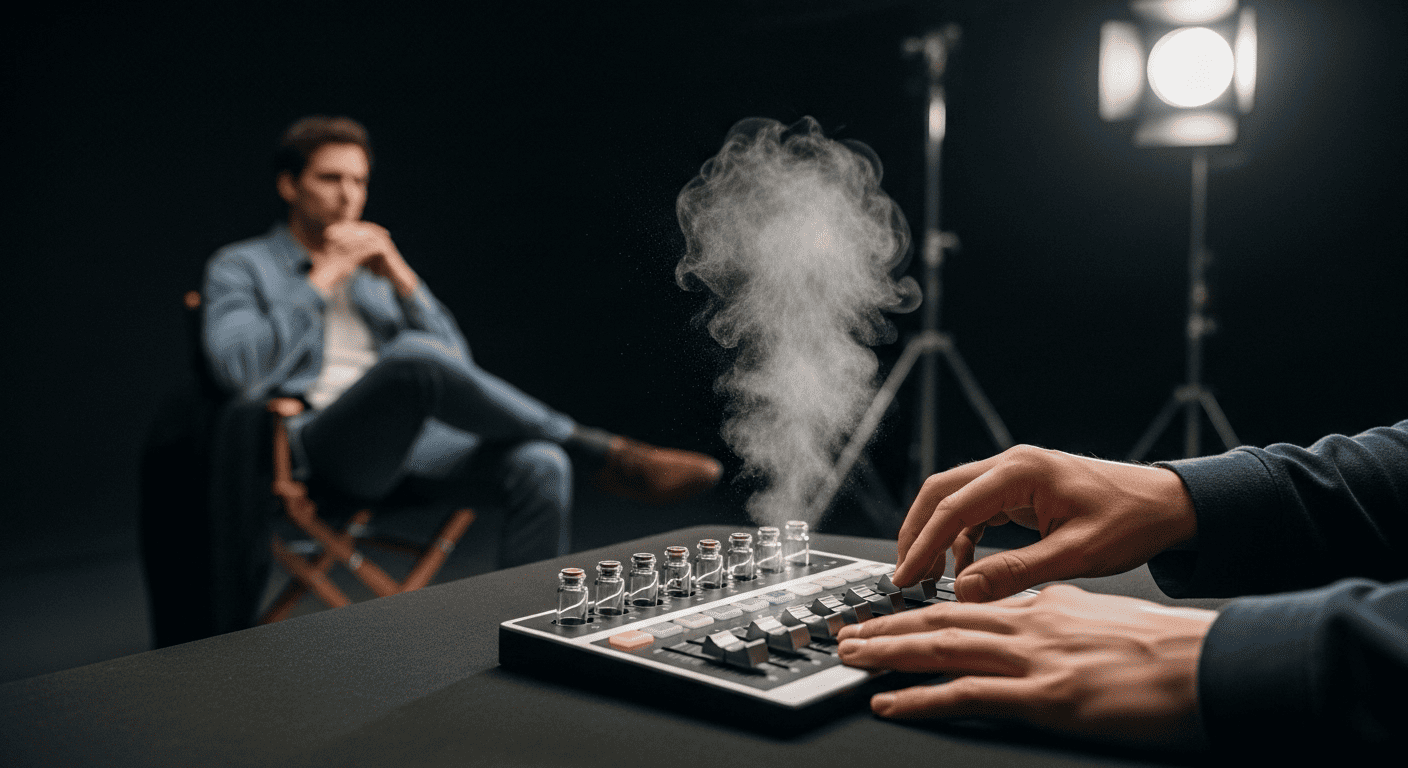Within a film’s meticulously crafted world, every visible object serves a narrative purpose, yet a director’s most influential instrument can be completely imperceptible. This invisible prop is a precisely targeted scent, released on set not for the audience, but as a direct stimulus for the actors. This application elevates perfumery into a potent medium for unlocking genuine, command-performance emotion.
This technique operates as a form of sensory bio-hacking, providing a methodical shortcut to visceral emotion that circumvents the often laborious process of emotional recall. An olfactory designer can construct the specific aroma of a childhood home or a sterile hospital, often with just a single potent molecule, to ground an actor in a moment. This allows for a performance that stems not from memory, but from a raw, immediate, and physically felt reaction.
This specialized field demands a unique artisan who operates at the crossroads of cinematic art, neurobiology, and chemistry. The designer must possess the skills of a master perfumer to build complex aromatic structures, alongside the insight of a psychologist to understand their emotional impact. Their craft stands as powerful evidence that the most effective tools of storytelling are often not those seen by the eye, but those experienced by the soul.
A Direct Pathway to Performance
The entire premise of using scent on set is built upon the unique architecture of the human brain. Unlike sight or sound, which are first processed and filtered by the rational thalamus, information from our olfactory receptors travels directly to the limbic system. This system, often called the “reptilian brain,” governs our most primal functions: emotion, memory, and instinct. Scent is given a VIP pass to the very core of our emotional being.
This direct emotional shortcut is what makes olfaction such a potent and reliable tool for influencing an actor’s state. The connection between a specific scent and a powerful memory (the Proust effect) is not a poetic notion but a hardwired neurological fact. An olfactory designer leverages this fact with scientific precision, using scent to trigger a desired emotional state—be it fear, nostalgia, comfort, or anxiety—without the actor having to consciously “work” for it.
The effect is both immediate and subtle, creating an authentic, physiological response that cameras can capture in an actor’s micro-expressions, posture, and tone of voice. This allows a director to achieve a level of nuanced, believable performance that might otherwise take hours of takes to coax out. It is a method of achieving emotional truth through chemical suggestion, a silent collaboration between the scent and the subconscious.
The Designer’s Olfactory Palette
An olfactory designer’s toolkit is far more sophisticated than a simple collection of commercial air fresheners, which are often too recognizable and distracting. Instead, they work with a carefully curated library of raw materials, blending them to create highly specific and evocative environmental aromas. This process is akin to a composer arranging musical notes to create a mood, only the notes are molecules.
These designers build their accords from a vast palette of materials, ensuring the final creation is unique and targeted. They must avoid familiar perfume profiles that could pull an actor out of the scene by reminding them of a person or a product. The goal is to create a background scent that feels authentic to the environment, providing a seamless sensory landscape for the actor to inhabit.
The work involves a precise blending of various components to achieve a desired emotional or environmental effect:
- Geosmin and Patchouli: To create the hyper-realistic smell of damp earth, wet soil after rain, or a decaying forest floor for scenes of grit, despair, or horror.
- Aldehydes and Ozonic Compounds: To craft the sterile, metallic, or electric scent of a spaceship, a futuristic lab, or the air before a lightning storm.
- Lactones and Vanillin: Used to build comforting, nostalgic scents of baked goods, old books, or the specific milky aroma of a nursery to evoke feelings of childhood and safety.
Scent as a Time Machine
The most powerful application of this technique is to use scent as a personal time machine for a specific actor. Before production, an olfactory designer may work with an actor to identify key scent memories from their own life that align with their character’s emotional journey. This custom-tailored scent is then diffused on set only during specific, critical scenes to trigger a genuine, personal, and deeply felt emotional response.
This bespoke approach elevates the craft from general mood-setting to a form of precision-guided emotional direction. For example, if a character is grieving their father, the designer might recreate the specific blend of pipe tobacco and old leather that the actor associates with their own father. The resulting performance is no longer just an interpretation of grief; it is a real, fleeting moment of it, captured on camera. This creates a layer of authenticity that is almost impossible to replicate through acting alone.
This method requires immense trust between the director, the designer, and the actor. The scent becomes a private signal, a secret trigger shared between them to unlock the deepest wells of performance. It is a delicate and respectful process that acknowledges the profound link between our personal histories and the aromas that define them, using that link to serve the art of storytelling.
Building Worlds, Not Just Moods
Beyond triggering specific emotions, olfactory design is also used for broader world-building, helping the entire cast and crew immerse themselves in the film’s environment. A consistent sensory backdrop makes the artificial set feel more tangible and real. This continuous sensory anchor helps actors stay in character between takes and maintain the illusion of the world they are supposed to inhabit.
On the set of a historical drama, for instance, a designer might continuously diffuse a low-level scent of coal smoke, horse leather, and damp wool to ground the actors in the 19th century. For a science fiction film, the constant, subtle hum of ionized air and sterile polymers can make a plywood spaceship set feel like a functioning vessel. This ambient scenting is less about triggering a peak emotion and more about maintaining a consistent reality.
This environmental approach transforms the set from a visual space into a multi-sensory one. It helps blur the lines between the real world and the fictional one, making the performance feel more natural and inhabited. The scent becomes part of the invisible architecture of the film’s universe, a foundational layer of reality upon which the actors can build their performances.
Frequently Asked Questions
No, with very few exceptions in niche experimental cinema (often called “Smell-O-Vision” or “AromaRama”), these scents are exclusively for the actors and crew on set. The goal is to improve the performance captured on camera, not to create a 4D experience for the theater audience. The scent’s effect is translated to the audience through the actor’s authentic performance.
The difference is precision, safety, and subtlety. A commercial candle has an easily recognizable, often synthetic, and overpowering scent that would be distracting. A designer creates a custom, high-fidelity scent that smells authentic to the environment (e.g., real damp earth, not a “Forest Rain” candle) and diffuses it in a controlled, hypoallergenic way to create a specific, targeted effect without being obvious.
This is a highly specialized, interdisciplinary field. Most olfactory designers have a background in professional perfumery or chemistry, which gives them the technical skill to construct and blend scents from raw aroma molecules. This is often combined with a deep knowledge of film production and an intuitive understanding of psychology and storytelling to effectively translate a director’s vision into an emotional, scent-based tool.

